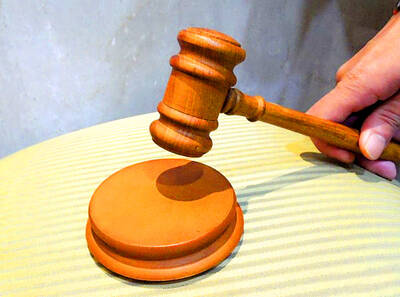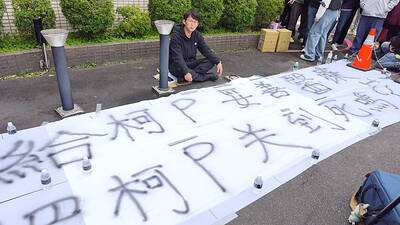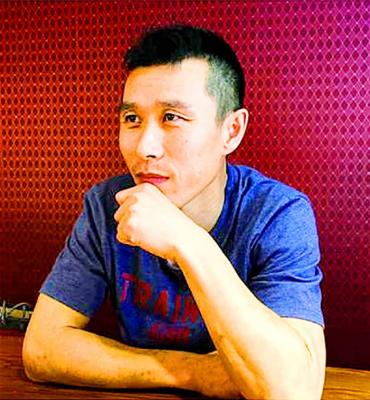“Had [former president] Chiang Ching-kuo (蔣經國) been taken care of, the infighting within the Chinese Nationalist Party [KMT] would have restarted and the KMT’s super-stable regime would have been destabilized. The idea was a great temptation to me,” said Peter Huang (黃文雄), the man who attempted to assassinate the then-vice premier and heir to Chiang Kai-shek (蔣介石) in New York City on April 24, 1970.
Huang, 80, made the comments at a salon, titled “From the Assassination of Chiang Ching-kuo to the Sunflower Movement: Individuality in Historical Events,” on Feb. 2 in Taipei.
Huang and his brother-in-law, Cheng Tzu-tsai (鄭自才), now 81, carried out the assassination attempt. They were caught, but jumped bail after pleading guilty and fled the US.
Huang returned to Taiwan in 1996 and has since worked as a human rights advocate. Cheng returned in 1991 and has worked as an architect, artist and independence campaigner.
The salon was a rare occasion that saw Huang and Cheng together discussing their motivation to kill Chiang Ching-kuo.
The unfolding of the assassination attempt is well-known — Huang was about to shoot Chiang Ching-kuo as he was entering his hotel, but a security agent knocked his arm upward, and the bullet missed.
Huang began his talk at the salon by telling a personal story, which eventually led to his assassination plot.
One of the first political enlightenments Huang had was in 1963, when he was a graduate student of journalism at National Chengchi University.
He confronted a foreign friend who was reading a magazine about the free world, or the Western bloc, during the Cold War, with Huang mockingly saying that the Republic of China (ROC) was part of the free world.
The friend told Huang that Francisco Franco’s Spain was as much a part of the free world as the ROC under the dictatorship of Chiang Kai-shek.
This worldview and the comparison between Franco and Chiang Kai-shek have stayed with him ever since, Huang said.
He began his studies in the US in 1964, first at University of Pittsburgh and later at Cornell University, where he was exposed to the free speech movement launched by students at the University of California, Berkeley, and different social movements in the US and other countries, including the opposition to the Vietnam War, Black Power movement, the feminist movement and Prague Spring.
“None of the students of my generation was insusceptible to the influence of the 1960s, and students coming from authoritarian countries to the Free World often shared their experiences living under authoritarianism,” Huang said.
Cheng, who studied at Carnegie Mellon University and later worked as an architect in New York City, was similarly exposed to the social movements of the time and was personally involved in protests against the Vietnam War, Black Power movement and student movements, he said.
Democracy, freedom and citizen empowerment were a real culture shock to the “Sputnik generation” — a term that Huang used to describe overseas students sent to the US since the 1960s as part of the space race against the Soviet Union — and the relentless social movements opened the eyes of people who had spent all their lives in a closed society muzzled by dictatorship, Cheng said.
Huang said he also joined the Taiwanese independence movement launched by US-based Taiwanese students, but was not actively involved because he was more preoccupied with street activism and because some Taiwanese independence supporters “harbored no suspicion at all about the US,” which aligned itself with dictators like Chiang Kai-shek and Franco, and had “unrealistic fantasies” about US assistance to Taiwanese independence.
“What I focused on was the super stable control of Taiwan by the Chiang family and the unshakable structure of its party-state. I paid attention to social movements [in the US] because I believed they could be brought back to Taiwan and used to foster a civil society. The US had the tradition of civil resistance and civil disobedience, which Taiwan did not have,” Huang said.
“Unlike Taiwanese independence activists of the time, I never said I wanted to topple the KMT, or ‘make the KMT disappear from the Earth’ as some famous individual [Hsu Hsin-liang (許信良)] claimed. What I was thinking of was to destabilize the super-stable regime and open up a space for Taiwan’s civil society,” Huang said.
Had Chiang Ching-kuo been removed, the KMT’s iron grip on Taiwan would have been disrupted, an idea that was a great temptation to him, Huang said.
“Even more tempting was something I gathered from my American experiences. Cornell University as an Ivy League member was a common destination for dictators visiting the free world, and their security measures were often very inadequate,” Huang said.
“Because of that, I immediately said yes when Tzu-tsai asked me to join the assassination [plot],” he said.
“The level of Chiang Ching-kuo’s security was incredibly low. I was able to walk up to him, but unfortunately a New York City police officer was quick to react and shoved my hand, so I missed,” he said. “The failure was also part of history.”
“Karl Marx said a person’s consciousness is shaped by the environment, but why were there only two people, who were as equally exposed to the contemporary environment as Taiwanese students in the US, who attempted to take the life of Chiang Ching-kuo?” Cheng said.
The independence movement Huang and Cheng led and helped inspire was connected with the global trend, and the assassination should be viewed in the light of post-war decolonization and the social revolution of the 1960s, Academia Sinica historian Wu Rwei-ren (吳叡人) said.
The two were exposed to the New Left movements in the 1960s, and they were equally influenced by the Vietnamese nationalist movement during the Vietnam War, the Irish War of Independence and Palestinian independence movement, Wu said.
Their personal experiences were a microcosm of the broader Taiwanese independence movement of the time, which was inextricably linked with the New Left movements and decolonization movements of the Third World, Wu added.
The assassination was “a spinoff of the social revolution across the globe since 1968” and could be described as “a left-wing Taiwanese independence movement when there was no left-wing Taiwanese independence,” he said.
“The assassins were leftists in a loose sense of the word, and what they believed in was not any doctrinal leftism, but the possibility of Taiwan’s social justice and social liberation,” Wu said.

The High Prosecutors’ Office yesterday withdrew an appeal against the acquittal of a former bank manager 22 years after his death, marking Taiwan’s first instance of prosecutors rendering posthumous justice to a wrongfully convicted defendant. Chu Ching-en (諸慶恩) — formerly a manager at the Taipei branch of BNP Paribas — was in 1999 accused by Weng Mao-chung (翁茂鍾), then-president of Chia Her Industrial Co, of forging a request for a fixed deposit of US$10 million by I-Hwa Industrial Co, a subsidiary of Chia Her, which was used as collateral. Chu was ruled not guilty in the first trial, but was found guilty

DEADLOCK: As the commission is unable to forum a quorum to review license renewal applications, the channel operators are not at fault and can air past their license date The National Communications Commission (NCC) yesterday said that the Public Television Service (PTS) and 36 other television and radio broadcasters could continue airing, despite the commission’s inability to meet a quorum to review their license renewal applications. The licenses of PTS and the other channels are set to expire between this month and June. The National Communications Commission Organization Act (國家通訊傳播委員會組織法) stipulates that the commission must meet the mandated quorum of four to hold a valid meeting. The seven-member commission currently has only three commissioners. “We have informed the channel operators of the progress we have made in reviewing their license renewal applications, and

Taiwan People’s Party (TPP) Chairman Huang Kuo-chang (黃國昌) yesterday appealed to the authorities to release former Taipei mayor Ko Wen-je (柯文哲) from pretrial detention amid conflicting reports about his health. The TPP at a news conference on Thursday said that Ko should be released to a hospital for treatment, adding that he has blood in his urine and had spells of pain and nausea followed by vomiting over the past three months. Hsieh Yen-yau (謝炎堯), a retired professor of internal medicine and Ko’s former teacher, said that Ko’s symptoms aligned with gallstones, kidney inflammation and potentially dangerous heart conditions. Ko, charged with

Taiwan-based publisher Li Yanhe (李延賀) has been sentenced to three years in prison, fined 50,000 yuan (US$6,890) in personal assets and deprived political rights for one year for “inciting secession” in China, China's Taiwan Affairs Office spokesman Chen Binhua (陳斌華) said today. The Shanghai First Intermediate People’s Court announced the verdict on Feb. 17, Chen said. The trial was conducted lawfully, and in an open and fair manner, he said, adding that the verdict has since come into legal effect. The defendant reportedly admitted guilt and would appeal within the statutory appeal period, he said, adding that the defendant and his family have